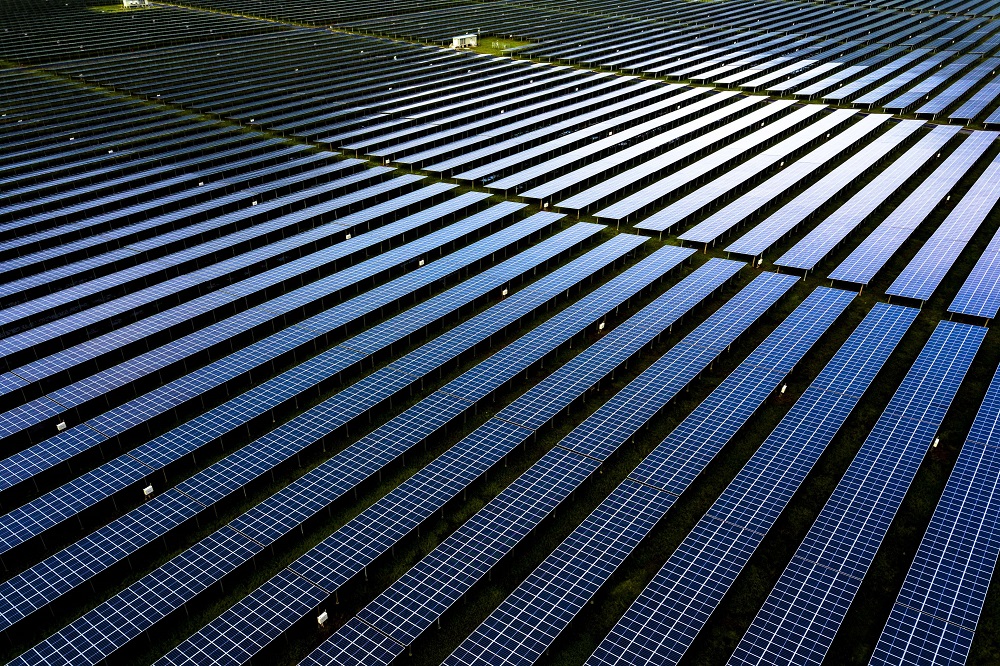While Vietnam is facing a shortage of power and coping with natural disasters and climate change, developing renewable energy, including wind, solar and biomass, seems to be a suitable solution and essential trend. Bringing about high efficiency, solar power has been produced and used in many places across the country.
Solar power solutions, despite drawing attention from many investors, have yet to be adopted widely as most of investors are not financially strong enough to venture into the solar power sector due to multiple obstacles related to preferential policies and electricity prices. However, a few major groups in the country have broken through the barriers in terms of procedures and have for many years prepared for their participation to begin the trend of using clean energy which will be a future choice.
Desire for being the “leader of the crane flock”
In May 2017, Sao Mai Group put into operation its rooftop solar power plant with a capacity of 1.06 megawatt peak (MWp) at a total cost of US$2 million, which was the largest of its kind in Vietnam then.
Years later, rooftop solar power saved hundreds of billions of Vietnamese dong from electricity bills for International Development & Investment Corporation (IDI). More importantly, Sao Mai Group has successfully used renewable energy in processing seafood for export. The group was appreciated by the world for its pioneering spirit.
From 2019 to 2020, Sao Mai Group continued to build a solar power plant, Sao Mai Solar PV1, covering an area of some 300 hectares in Tinh Bien District in An Giang Province, with a total capacity of 210 MWp and total investment of over VND6 trillion. During the same period, Sao Mai Solar PV2, with a total capacity of 50 MWp, in Long An Province was also put into operation.
The installation of major equipment for the second phase of Sao Mai Solar PV1 with a capacity of 106 MWp has recently started. The project is set to be connected to the national grid on December 31 this year. Thanks to its effective operations, Sao Mai Group’s revenue from electricity sales to Vietnam Electricity Group (EVN) has increased steadily, in spite of the difficulty caused by Covid-19.
At the end of 2020, Sao Mai solar power plants will generate an estimated 500 million KWh of electricity per year. After the group’s solar power projects are completed as planned, the total output of power will be some 2.5 billion KWh per year in the next 10 years.
“In late 2020, Sao Mai Group will add some 400 million KWh of electricity per year to An Giang Province’s power grid. This is clean energy which is valuable, especially when Vietnam is facing a shortage of power. Besides, the local budget will be supplemented with some VND80 billion from value-added tax and over VND40 billion from corporate income tax. With a total capacity of 210 MWp DC, the group will fetch some VND800 billion from electricity sales to EVN, with the purchase price at 9.35 U.S. cents per kWh in the first phase and at 7.09 U.S. cents per kWh in the second phase,” says a representative of Sao Mai Group.
As Sao Mai Group is focusing on renewable energy development, the group has completed necessary procedures to deploy two big solar power projects in Cu Jut District of Dak Nong Province and in Ea H’leo District in Daklak Province. The plant in Dak Nong is set to cover 754 hectares and have a capacity of 875 MWp while the other will have a capacity of 450 MWp and span 352 hectares.
Solar Farm
Sao Mai Group has unlocked the potential of renewable energy in some localities which have high radiation levels and low efficiency of production. The group’s projects are expected to make contributions to the localities and help residents improve their quality of life. Underneath hundreds of large solar panels, barren farmland has improved gradually and served for hi-tech organic cultivation.

Sao Mai Solar has started a new tourism type, in which tourists can explore and go on tours to solar farms.
“Behind Sao Mai Solar Power Plant are the mountains and in front of the plant are vast paddy fields, and the plant is located in a semi-mountainous area. With available advantages and beautiful landscape, such a tourist site is promising to attract many visitors,” said a representative of Sao Mai Group.
The solar tourism model is familiar in many countries, but this is still strange in Vietnam. Questions about how to generate power from solar panels will be answered by tourists by “touching, watching and listening.” Viewed from a different angle, this is also a way to prove the shift of a firm in the Industry 4.0 era.
Solar Farm Tourism is a different definition of hi-tech tourism model. Sao Mai Solar will create a powerful influence, bringing high values to economic and political development. Each of the investor’s careful steps has reflected its desire to become EVN’s strategic power supplier and own the typical Solar Farm tourism model in Asia.











